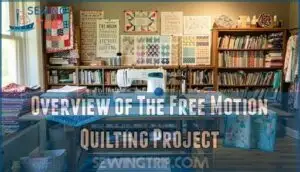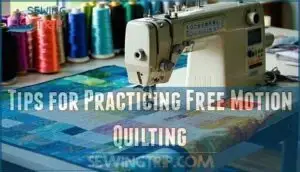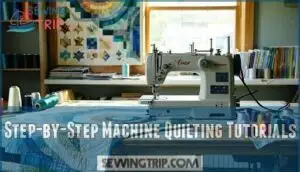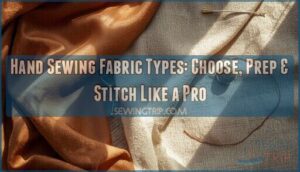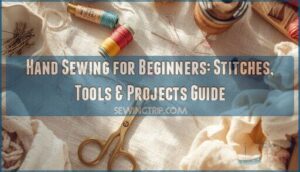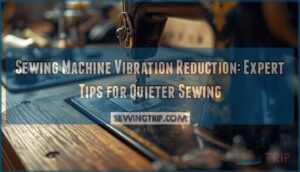This site is supported by our readers. We may earn a commission, at no cost to you, if you purchase through links.
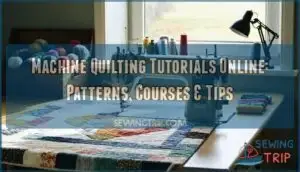 Your first quilt sandwich sits under the presser foot, pins holding three layers together, and suddenly you’re not sure where to begin. That moment of hesitation is exactly why machine quilting tutorials online have become the go-to resource for quilters at every level.
Your first quilt sandwich sits under the presser foot, pins holding three layers together, and suddenly you’re not sure where to begin. That moment of hesitation is exactly why machine quilting tutorials online have become the go-to resource for quilters at every level.
Instead of wrestling with guesswork or piecing together advice from fragmented sources, you can watch an expert guide your needle through each pattern, building confidence one stitch at a time. The right tutorial doesn’t just show you what to do—it walks you through the why, the how, and the little tricks that transform a wobbly beginner line into smooth, controlled stitching that brings your quilt to life.
Table Of Contents
Key Takeaways
- Machine quilting tutorials online transform hesitation into skill by showing not just what to stitch, but why and how—building confidence through expert demonstrations that turn wobbly beginner lines into smooth, controlled stitching.
- Free Motion Quilting Project offers over 100 video tutorials (designs 201-300) that act like a personal mentor, giving you step-by-step patterns matched to your skill level so you can practice with intention and build muscle memory faster.
- You don’t need expensive longarm equipment to create professional results—domestic machines work brilliantly for quilting when paired with proper technique, the right tutorials, and consistent practice on foundational skills like tension control and fabric management.
- Connecting with quilting communities through online forums, workshops, newsletters, and YouTube series keeps your creativity flowing while providing troubleshooting support, inspiration, and collaborative learning opportunities that accelerate your growth.
Getting Started With Machine Quilting
Machine quilting opens up a world of creative possibilities once you’ve got the right foundation in place. Before you jump in, you’ll want to gather a few key supplies, understand your machine options, and set up your workspace properly.
Let’s walk through what you need to get started on the right foot.
Essential Tools and Supplies for Machine Quilting
Before you can stitch your first pattern, you’ll need to gather the right tools—think of them as your quilting toolkit that turns fabric layers into a finished masterpiece. Start with quality thread types that won’t snap under tension, batting materials that give your quilt loft, and sharp quilting needles designed for your sewing machine.
Add fabric cutters for clean edges and a sturdy sewing table to support your work as you explore machine quilting tutorials and patterns.
Understanding Domestic Vs. Longarm Machines
Once you’ve got your toolkit ready, the next decision is choosing between a domestic sewing machine you already own or investing in a specialized longarm—and it’s easier than you think to figure out which one matches your quilting ambitions.
Domestic machines work great for home machine quilting on smaller projects, especially with stitch regulation features and the right thread types.
Longarm quilting uses frame systems and offers more quilting space, perfect for tackling king-sized quilts.
Machine quilting tutorials for both styles show you machine comparison details, so you can master machine quilting patterns on whichever setup fits your creative goals.
Basics of Layering, Marking, and Basting Quilts
Now that you’ve picked your machine, it’s time to learn the three-step foundation that turns fabric and batting into a quilt ready for stitching—layering, marking, and basting. This quilting tutorial makes quilting for beginners feel totally doable:
- Layering order: backing fabric (face down), batting, top (face up)—smooth each layer flat
- Marking tools: chalk or washable pens guide your machine quilting techniques without guesswork
- Basting sprays: secure layers fast; pins work too, but watch thread tension for smooth stitching
These quilting tips set you up for success!
Safety Tips and Workspace Setup
Before you fire up your machine, let’s talk about setting up a workspace that won’t leave you with a sore back or a tangled mess of thread. Ergonomic setup matters—adjust your sewing machine height so your elbows rest at ninety degrees.
Good workspace lighting prevents eyestrain and helps you spot tension issues fast. Keep your quilting tools within arm’s reach, and regularly check your quilting machine for loose screws or lint buildup—machine maintenance is injury prevention in disguise.
Exploring Free Motion Quilting Patterns
Free motion quilting opens up a world of creative possibilities once you get the hang of it. The Free Motion Quilting Project offers hundreds of designs to help you build your skills and confidence at your own pace.
Let’s look at how this resource works, what patterns you can access, and how to make the most of your practice time.
Overview of The Free Motion Quilting Project
The Free Motion Quilting Project is like having a generous quilting mentor who’s shared over 100 patterns—complete with video tutorials—so you can jump straight into stitching without guessing your way through new designs.
Each tutorial walks you through the motions step-by-step, so you’re never stuck wondering what comes next. It’s the kind of resource that builds your confidence fast and keeps your creativity flowing.
Accessing and Choosing Patterns (Designs 201–300)
You’re about to access a treasure chest—designs 201 through 300 offer remarkable variety for every skill level and creative direction. Finding the right pattern for your project means thinking through your quilt’s personality and your comfort zone at the machine.
When you’re browsing these quilting patterns, keep these priorities in mind:
- Pattern complexity – Match the design evaluation to your current free motion quilting skill so you’re challenged but not overwhelmed
- Quilt planning – Consider how the quilting designs will complement your piecing and overall layout
- Fabric choice – Patterns show differently on busy prints versus solids, so preview mentally before committing
- Thread options – Decide whether you want the stitching to pop or blend for maximum impact
- Video accessibility – Each machine quilting pattern includes a tutorial, making learning smooth and confidence-building
Start with one that sparks joy, then let your creativity lead. For more guidance, explore the various machine quilting techniques to boost your skills.
Tips for Practicing Free Motion Quilting
Learning to quilt freely takes patience, but building muscle memory happens faster when you practice with intention and a few smart shortcuts. Start with Free Motion Basics on scrap fabric—no pressure, just motion. Experiment with Quilting Speed Control and Stitch Regulation settings until your rhythm feels natural.
Pay attention to Fabric Tension and Thread Choice; they’ll make or break your flow. Watch quilting tutorials repeatedly, then try simple free motion quilting patterns. Soon, these machine quilting techniques become second nature.
Step-by-Step Machine Quilting Tutorials
Learning machine quilting works best when you build your skills one step at a time. Whether you’re just starting out with straight lines or ready to tackle a king-sized project, the right tutorial makes all the difference.
Here’s how to grow your quilting confidence from beginner basics to expert artistry.
Beginner Techniques: Straight-Line and Simple Patterns
Straight-line quilting is your best friend when you’re just starting out—it’s forgiving, builds confidence fast, and gives you a solid foundation before you tackle anything fancier.
Start with basic machine setup and thread color selection that complements your quilting fabric choices. Try simple pattern designs like grids or diagonal lines—these straight line stitching techniques help you master tension and speed without feeling overwhelmed.
Intermediate Free Motion Skills
Once you’ve got straight lines down, it’s time to drop those feed dogs and let your hands do the driving—free motion quilting is where the real fun begins. Here’s what to focus on as you level up your FreeMotion quilting skills:
- Master stitch control by moving fabric at a steady pace—too fast creates tiny stitches, too slow burns thread.
- Experiment with thread choices to see how different weights change your quilting techniques and texture.
- Practice fabric manipulation using these free motion tips: gentle pressure, smooth movements, eyes ahead.
Check out the Free Motion Quilting Project’s video tutorials—designs 201-300 give you solid sewing machine quilting patterns to build confidence.
Advanced Designs and Creative Techniques
Ready to push past the basics and design quilts that make people lean in for a closer look? Expert feathers, artistic fillers, and intricate stitches turn your work into art. Layer quilt embellishments with creative borders using these FreeMotion quilting techniques:
| Technique | Best For | Difficulty |
|---|---|---|
| Expert Feathers | Focal points, borders | High |
| Artistic Fillers | Background texture | Medium-High |
| Creative Borders | Frame designs | Medium-High |
| Intricate Stitches | Detail work | High |
| Layered Embellishments | Dimensional effects | High |
Mix quilting patterns boldly—your machine quilting becomes your signature when you trust creative quilting techniques.
Quilting a King-Sized Quilt on a Home Machine
You’ve conquered the fancy stitches—now let’s talk about wrangling a king-sized quilt through your home machine without losing your mind. Roll and clip the bulk tight so you’re steering fabric, not wrestling it.
Tackle king-sized quilts in sections using simple machine quilting patterns—straight lines or gentle curves keep domestic machine quilting manageable.
Choose quality thread and practice fabric management before diving into quilting large projects on your home machine.
Learning Platforms, Courses, and Events
You’ve got plenty of ways to level up your quilting skills, whether you prefer learning at your own pace online or joining live workshops.
From extensive courses that walk you through every technique to free video lessons and hands-on events, there’s something for every learning style.
Let’s look at the platforms and opportunities that can help you master machine quilting.
Online Machine Quilting Courses by Cindy Seitz-Krug
Cindy Seitz-Krug’s "Successful Machine Quilting: Basic & Beyond" gives you a clear path from beginner to confident quilter. This six-lesson course covers everything—marking, basting, straight-line stitching with a walking foot, and free-motion quilting techniques. You’ll even learn how to wrangle a king-sized quilt on your home machine.
- Course Structure: Six lessons totaling about 2 hours and 10 minutes, available for streaming or on DVD
- Quilting Techniques: Progress from straight-line quilting to intricate free-motion designs like feathers and pebbles
- Student Progression: Beginners who’ve taken Cindy’s classes have won blue ribbons at competitions
Cindy brings 30+ years of experience and major awards to her teaching. Her machine quilting tutorial breaks down complex machine quilting patterns into manageable steps, with hands-on tips for machine setup and troubleshooting.
Preview the quilting class before you commit—it’s a smart way to see if her teaching style clicks with you.
Workshops and Events at The QIMT Event Center
If workshops and instructor-led formats appeal to you, QIMT Event Center in Liberty, MO delivers hands-on Quilting Workshops across all skill levels. Beginner Quilting Classes run $120, longarm training sessions cost $129, and three-day Quilt Retreats—complete with catered meals and Studio Access—are $179. Regular events like EPP Club and Building A Quilt 101 foster Community Engagement and peer learning. For those interested in machine quilting, exploring quilting design resources can help improve skills.
| Event Type | Price | Focus |
|---|---|---|
| Beginner Class | $120 | Foundational Skills |
| Longarm Training | $129 | Professional Equipment |
| Spring Retreat | $179 | Studio Time + Meals |
Ricky Tims’ Free Machine Quilting Lessons
If you’d prefer to learn at your own pace without spending a dime, Ricky Tims offers free access to his online classroom packed with machine quilting lessons and video tutorials.
You’ll find Free Motion Tips, Quilting Techniques and Tips, and guidance on Machine Setup—whether you’re stitching on a domestic machine or exploring Longarm Quilting.
The Stitch Variety keeps things interesting, and Quilter Feedback confirms these resources genuinely help you tackle real Quilting Projects with confidence.
Newsletters and Ongoing Learning Opportunities
Staying connected to fresh ideas and new techniques is easier when you sign up for quilting newsletters that land right in your inbox. You’ll discover Quilting Updates, Quilt News, and Educational Resources customized to your Learning Paths—whether you’re mastering Quilting Techniques and Tips or diving into online forums.
These channels keep Quilters Education alive, connecting you to the Quilting Community and Resources while offering regular Quilting Tutorial recommendations that spark creativity and confidence.
Connecting With The Quilting Community
You’re not alone in this quilting journey—there’s a whole world of makers out there ready to share ideas, cheer you on, and swap tips.
Connecting with other quilters creates opportunities to fresh inspiration and keeps your creativity flowing.
Here’s how to tap into that supportive network and find your people.
Sharing and Learning Through Quilting Communities
Joining a quilting community reveals opportunities you never knew existed. Whether you’re hunting for Quilting Therapy, Mental Health Benefits, or just better skills, these groups deliver. Here’s what makes them powerful:
- Community Outreach and Collaborative Projects connect you with charitable causes and activist quilting campaigns
- Social Media Impact brings together quilters across backgrounds—members post around 60 times yearly in active groups
- Quilting Education happens naturally through mentorship, with seasoned quilters guiding newcomers
The Quilters Community thrives on shared knowledge in Sewing and Quilting spaces online and in-person.
Midnight Quilter YouTube Series for Inspiration
When everyone else has packed up their sewing room for the night, the Midnight Quilter series lights up your screen with projects made for after-hours stitching sessions. You’ll find quilting tutorials that fit those creative nights when your sewing machine calls and sleep can wait.
The videos share midnight projects alongside quilting tips and tricks—plus snack recommendations that keep your energy up. It’s quilting inspiration designed for the quilter community who stitches best after dark, offering night quilting tips that honor your creative rhythm.
Quilt Pattern Galleries and Showcases
Scrolling through quilt pattern galleries online is like walking into a museum where every piece tells a story—and yours could be hanging on that wall next.
Check out quilting design gallery showcases to explore:
- Quilt patterns and designs featuring stunning quilt tops in every style
- Quilter profiles sharing fabric selection choices and creative approaches
- Gallery tours highlighting pattern showcases that spark your next project
These spaces celebrate quilt design while fueling your imagination.
Tips for Growing Your Quilting Network
Building your quilting network isn’t about collecting contacts—it’s about finding your people, the ones who get excited when you mention thread tension or discover a new ruler.
Start by joining quilting groups and online forums where you can swap tips after every quilting tutorial. Attend quilt shows and networking events to meet quilting friends face-to-face.
Take a quilting workshop or sign up for classes—the sewing and crafting community thrives when we learn together.
Frequently Asked Questions (FAQs)
How do you troubleshoot thread tension issues?
Perfect tension seems impossible—ironically, it’s rarely the thread’s fault. Start with your bobbin: check for lint buildup and proper threading.
Rethread your top thread completely, adjusting the tension dial gradually. Test on scrap fabric between each adjustment to monitor stitch quality improvements.
What fabrics work best for beginner quilters?
Cotton is your best friend when you’re starting out. It’s forgiving, holds its shape during Sewing Techniques, and doesn’t stretch or slip around.
Look for 100% cotton quilting fabric—it manages beautifully for weaving layers together and pairs perfectly with cotton batting options.
How do you prevent puckering while quilting?
Ever wonder why fabric bunches up mid-stitch? Proper fabric tension, batting selection, and quilting speed prevent puckering.
Adjust thread choice, use stitch regulation, and practice straight-line stitching in quilting tutorials.
Both domestic machine quilting and longarm quilting require consistent tension control throughout.
Can you quilt without a walking foot?
You can quilt without a walking foot using free motion techniques. Drop the feed dogs, switch to a darning foot, and control fabric guidance manually.
Stitch regulation and tension control become your responsibility—domestic machine quilting tutorials can help you master this skill.
How do you finish quilt edges after quilting?
Your quilting journey culminates in the final flourish—binding. Trim excess fabric, leaving quarter-inch seam allowances. Attach binding strips using sewing seams, then fold over edges. Hand-stitch or machine-finish for polished quilt borders that frame your masterpiece beautifully.
Conclusion
Think you need a fancy longarm to quilt like a pro? You don’t. With the right machine quilting tutorials online, your home machine becomes a powerful tool for any design you can imagine.
Start with one pattern, practice until your hands move without thinking, then layer on the next skill. Each stitch you take builds muscle memory that turns hesitation into flow.
Your quilt isn’t waiting for perfect conditions—it’s waiting for you to press that pedal and begin.
- https://www.quintessentialquilting.com/shop/online-classes
- https://thequiltshow.com/learn/category/expert-seminars/30-tips-and-tricks-for-better-machine-quilting-with-cindy-seitz-krug/machine-quilting-30-tips-conclusion-cindy-seitz-krug
- https://quiltingismytherapy.com/angela-walters/
- https://www.instagram.com/p/DFOCNWIIjgO/
- https://craftindustryalliance.org/the-size-of-the-quilting-market-quilting-trends-survey-results-2025/

